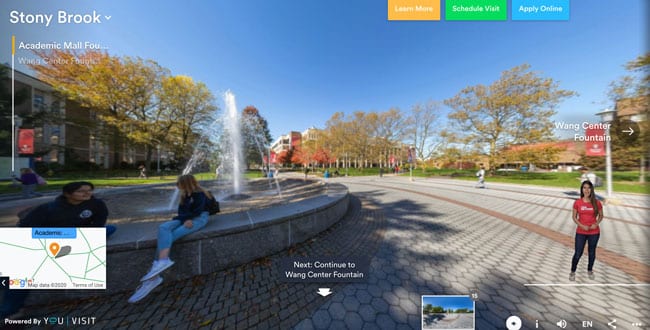Part
01
of one
Part
01
Virtual Tour Best Practices
Key Takeaways
- Understanding the needs of the target audience is one of the best practices in virtual campus tours.
- Another best practice specifically for higher education virtual tours is the putting up of a virtual tour communication plan which can be utilized during and after the tour. This is a best practice because it makes sure that the audience sees and engages with the tour.
- Adding trivia and anecdotes in virtual tours is also a best practice. This is a best practice because it was observed to increase engagement.
Introduction
This research presents five best practices in campus virtual tours. This includes a description of the best practice, the reason for being a best practice, and some industry experts discussing the best practice. The details are outlined below.
Understand the Needs of the Target Audience
- Understanding the needs of the target audience is one of the best practices in virtual campus tours.
- This is a best practice because it allows the showcase of the campus with the goal of not just meeting but also surpassing audience expectations. This would also help identify what should be shown in the virtual tour.
- According to Concept3D, "No single tour, of course, can satisfy all of these audiences. Instead, any experience built has to be nuanced for each of them."
- ICEF Monitor recommends showcasing the different kinds of available food inside or near the campus. Support services may also be included.
Go Beyond the Campus
- Going beyond the campus tour is also a best practice. This is a best practice because a virtual tour that features the environment outside the campus or surrounding the campus is as important to potential students.
- A writer from Concept3D notes that a virtual tour featuring the surrounding environment helps students decide whether they can be comfortable on the campus.
- The surrounding environment may include the local downtown, dining spots, and shopping areas.
Have a Follow-Up Communication Plan
- Another best practice specifically for higher education virtual tours is the putting up of a virtual tour communication plan which can be utilized during and after the tour. This is a best practice because it makes sure that the audience sees and engages with the tour.
- The virtual tour communication plan may include a prominent spot on the campus website or integration on the university's mobile app.
- According to Concept3D, text messages and regular emails may also be included in the follow-up communication plan. The Children's Center also highlights the chat feature of Zoom for its virtual tour.
Keep it Dynamic
- Another best practice in campus virtual tours is to keep tours dynamic. This is a best practice because it allows students to not feel like the tour is a presentation that they have to sit through. The image below shows a screenshot of Stony Brook University's virtual tour.
- ICEF Monitor recommends a dynamic tour wherein the structure is centered around the students' questions. The tour should also move around and feature different perspectives. It would also help if tour participants could engage with various university stakeholders.
- According to vFairs, a virtual event platform, "Have the faculty deliver webinars and the university admin head Q&A sessions and power chats. At the same time, have a booth or auditorium dedicated entirely to enable visitor interactions with existing students and university alumni. Here, the former can give prospective students a candid take on the campus life, and the latter can share some insight on the employed life post-graduation."
Incorporate Trivia and Anecdotes
- Adding trivia and anecdotes in virtual tours is also a best practice. This is a best practice because it was observed to increase engagement.
- According to virtual tour platform Mapme, "Incorporating trivia and anecdotes into your interactive campus tour offers a fun way to increase engagement, teach interesting facts about your school, and make the overall experience of your virtual campus tour more memorable."
Research Strategy
For this research on Virtual Tour Best Practices, we leveraged the most reputable sources of information in the public domain, including Concept3D, The Children's Center, ICEF Monitor, and Mapme.
